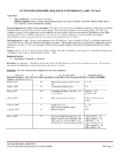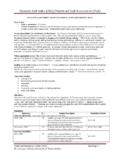Transcription of Six-Minute Walk Test (6MWT)
1 Six-Minute walk Test (6 MWT). Measurement of Ambulatory Endurance in Adults Teresa M. Steffen, PhD, PT Research Professor in Rueckert-Hartman College for Health Professions, Regis University, 3333 Regis Boulevard, G-4, Denver, CO 80221-1009. 414 213 4280 Reid Nelson, PhD Associate Professor, Concordia University Wisconsin Abstract: Ambulatory endurance is important for older adults interested in participating in life situations, particularly in the community. This paper reviews distance requirements for community ambulation and three measures for quantifying ambulatory endurance. The measurement properties of the Six-Minute walk test are described. Seventy-five percent of individuals in inpatient rehabilitation find community ambulation to be essential or very important to Ambulatory endurance is a prerequisite to such ambulation.
2 Measures such as the widely used Functional Independent Measure (FIM), which describes independent ambulation as walking a minimum of 46 meters without help or a device, do not capture If problems of ambulatory endurance are to be identified and goals to be established, ambulatory distances required in the community must be considered. Andrews et al, recently described mean distance (standard deviation) requirements needed if individuals are to manage in the community: post office = 52 (23) meters (m), bank = 57 (21) m, medical = 66. (32) m, pharmacy = 206 (27) m, department store = 346 (69) m, grocery store = 380 (86) m, hardware store = 566 (39) m, superstore = 607 (101) m and club warehouse = 677 (159) The authors stated that these distances have not changed significantly since Lerner-Frankiel et al published their study reporting mean distances for some similar community The distance walked during the performance of one instrumental activity of daily living task such as shopping or visiting a healthcare practitioner has been described as 304 m for 17 subjects with disabilities (average age 83) and 367 m for 19 without disabilities (average age 78).
3 5, 6 Brown et al, in a survey of older adults, identified a mean minimum distance for community ambulation to most locations as just less than 200 m; the mean maximum distance was less than 600 Exceptions to these minimum and maximum distances were for hospital visits and for trips to shopping malls and superstores. These results were similar to, but more conservative than those of Cohen et al, who determined the maximum distance an elderly individual needed to be able to walk to be considered functional in the community was 360 They, however, noted that most subjects had two destinations per trip, making 720 m a requirement for community ambulation. Though the actual testing of ambulatory endurance in the community setting is not practical for clinicians working with older adults, there are established tests that can inform as to ambulatory endurance.
4 Background The 6 MWT was developed by Balke in1963 as a physical performance measure of functional The test was modified from the 12 minute walk test originally developed by Cooper and measures the maximum distance a person can walk in six minutes over a flat The test has since gained clinical acceptance due to its ease of set up, administration, patient tests and Measures: Adult: 2012. Do not copy without permission of Teresa Steffen 6 MWT Page 1. Six-Minute walk Test (6 MWT). tolerance, reproducibility and similarity to requirements of patient function and participation. The 6 MWT has been used for morbidity and mortality prognosis in clients with left ventricular dysfunction,10 chronic obstructive pulmonary disease (COPD),11, 12 heart failure (HF),13, 14.
5 Primary pulmonary hypertension (PPH)15, 16 and to guide assessment for , 18 It is now also used in clients with cerebral palsy, stroke, multiple sclerosis, Parkinson disease, orthopedic conditions such as hip and knee surgeries, fibromyalgia, and for people with cancer. The 6 MWT. is appropriate in clients for whom endurance is a functional issue and improvement in ambulation endurance will reduce participation restrictions. Contraindications: The American Thoracic Society (ATS) has identified absolute contraindications to performing the 6 MWT as any individual who has unstable angina and/or has had a myocardial infarction during the previous Relative contraindications include a resting HR >120 beats per minute, systolic blood pressure >180 mmHg or a diastolic blood pressure >100 mmHg.
6 Although the ATS has listed a myocardial infarction within the last month as an absolute contraindication, another research team tested stable subjects within a week of an uncomplicated myocardial infarction and found the 6 MWT to be a safe and reproducible measure of functional Test Protocol The 6 MWT is often administered in a hall corridor and could also be done on a treadmill however, treadmill times are often Distance achieved should be recorded in meters (m) as most reference data for the test is presented in international units. Ideally, the course should be 30 meters but is often shorter due to shorter hallway distances in many facilities. Turnarounds should be well marked. Instructions from the American Thoracic Society19. The client should sit at rest in a chair located near the starting position for approximately 10.
7 minutes before the test starts. During this time, the pulse and blood pressure should be checked. While standing, the client should rate his/her baseline shortness of breath and fatigue using an appropriate rating scale. The client is told: The object of this test is to walk as far as possible for 6 minutes . You will walk back and forth in this hallway. Six minutes is a long time to walk , so you may be exerting yourself. You may get out of breath or become tired. You are permitted to slow down, to stop, and to rest as necessary. You may lean against the wall while resting, but resume walking as soon as you are able. You will be walking back and forth around the cones. You should pivot briskly around the cones and continue back the other way without hesitation.
8 The therapist should walk with subjects if they need supervision but not get ahead of them. The following feedback is all that should be provided: After the 1st minute: You are doing well. You have 5 minutes to go At 2 minutes : Keep up the good work. You have 4 minutes to go At 4. minutes : Keep up the good work. You have only 2 minutes left. At 5 minutes : You are doing well. You have only 1 minute to go With 15 seconds remaining in the test: In a moment I'm going to tell you to stop. When I do, just stop right where you are and I will come to you. At end of test: Stop! At completion pulse and blood pressure are measured, post- walk ratings for tests and Measures: Adult: 2012. Do not copy without permission of Teresa Steffen 6 MWT Page 2. Six-Minute walk Test (6 MWT).
9 Shortness of breath, fatigue, and exertion are recorded and the tested individual is asked to answer the question: What, if anything, kept you from walking farther? 19(p113-114). Factors that can affect Six-Minute walk test results: The distance achieved during 6 MWT can be affected by a number of different environmental or physiologic variables including: shorter height, age, increased body weight, gender, disease and the extent of disability within a diagnosis along with a shorter walking corridor causing more frequent In addition, the number of walk tests previously performed, encouragement during the test, administration of medication before the test and use of supplemental oxygen can all affect test , 28. The course layout does have an effect on the distance walked with circular or oval courses tending to allow subjects to walk further28, 29 although modifying the track from straight to circular had only a small effect change of 13 Comparable results between indoor and outdoor conditions were noted in a small study of individuals with COPD when reasonable outdoor climatic conditions were Research has shown that second and third trials of the 6 MWT tend to be better than the first trial, it is recommended that a practice trial (1or 2) be allowed and record the results of the ensuing , 20, 25, 27, 31-33.
10 Reliability Test retest reliability: Overall the 6 MWT test is very reliable with intraclass correlation coefficients (ICCs) of . , 29, 30, 33-53 The minimum detectable change (MDC)95, which is relevant to responsiveness, is large because the standard deviations of the people tested are high, meaning variation is large on ambulation endurance. In studies of individuals with neurologic disability, MDCs range from 20 m for people with chronic poliomyelitis40 to 106 m for people with multiple sclerosis41 and 86 m for those with Parkinson The MDCs for individuals with cardiac conditions range from 18 to 90 m and in one particularly large study of 786. subjects, an MDC95 of 74 to 86 m was A MDC95 of 87 m was noted in 470 individuals with lung disease who performed the 6 MWT on two successive In two separate studies of older adults, the MDC95 was shown to range between 77-94 , 51 Overall an MDC95 of 70-90.


